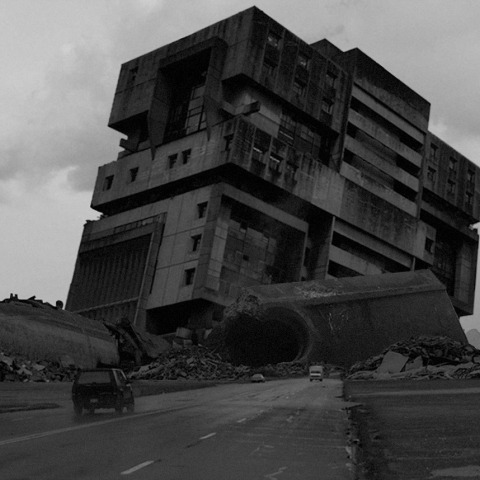Digitally manipulated photomontages present ruins of brutalist concrete structures within the desert and isolated landscape. Some of the buildings in his artwork are recognizable, while the others are completely modified until they become anonymous; Khojastehpay´s photographs don´t refer to any specific space or time. Because of the Islamic Revolution, Khojastehpay grew up in a Dutch refugee camp, bound by concrete. That would be the origin of his attraction to the Brutalism, "massive in character", and of the war atmosphere.
In all my images there is this bleak and grey atmosphere. This has to do with my Iranian background and is what I feel Iran and my family went through during the Islamic Revolution and the war.
I combine this with the urban environment I grew up at in The Netherlands, which mainly existed out of asphalt, bricks and concrete.
Pouria Khojastehpay creates mysterious dystopian, SCI-FI and abandoned landscapes. The protruding concrete brutalist structures and it's bleak atmospheres are primary elements in the artist's work. The photographs elude to human demise and destruction through the use of fictional and apocalyptic scenarios. “Freedom of interpretation”, Khojastehpay says, plays a massive role in his artwork as the viewer is coerced into a play upon the imagination. This ambiguity allows the work to cut through time and space, to evoke contemporary war conflicts or future human destruction.
"I try to evoke images of fictional contemporary war zones and conflict areas."
Influenced by Katsuhiro Otomo’s cyberpunk anime & manga Akira, and later dystopian novels by Philip K. Dick, George Orwell & J.G. Ballad, Pouria invites the viewers to “immerse themselves in the future failed landscapes of ruin” and create their own stories, interpreting the images; just like we translate words into visual images when reading books.
Description of the project by Shana Chandra
“We are the dead. Our only true life is in the future. We shall take part in it as handfuls of dust and splinters of bone. But how far that future may be, there is no knowing”
George Orwell, 1984.
‘Dystopian’ is a description often lavished upon 1984, Orwell’s classic work of literature. So too it is often used to epitomise images by Iranian artist, Pouria Khojastehpay, the title of which, Dustwound, was roused by Orwell’s words from the novel, above.
In Khojastehpay’s hands, Orwell’s ‘handfuls of dust’ are translated into desolate, desert landscapes, and mounds of mass rubble hinting at mankind’s capacity of creation and simultaneous destruction. The ‘splinters of bone’ are buildings in half-states of degradation, jutting out in angles no stable monument or ligament should, giving double meaning to their brutalist style. When the two are juxtaposed, the narrative examines human beings quest for longevity through the architecture it creates, and its destructive effects both aesthetically and environmentally on the land it inhabits.
In transplanting familiar edifices in the midst of upheaval, within landscapes often barren of life, Khojastehpay manipulates a degraded atmosphere that a ‘dystopia’ almost always suggests. In doing so, the structures rebound into their bereft surroundings the Ballardian perspective that “this was an environment built, not for man, but man’s absence.”
And yet Khojastehpay’s plans for Dustwound is for it to “become a small book about futures of the recent past”. When looked at through this lens, perhaps the destruction we witness in his images, which cannot be located in a specific time or space, is a moment on the cyclical pathway towards re-generation - to quote Orwell again - We are the dead. Our only true life is the future. Khojastehpay leaves this ambiguity of interpretation to the past and futures within each of us.

























![Ivo Precek, Pracovní tabule II [Work table II], 1965. "From the center of Europe. Czech photography, 1912-1974". Image courtesy of Juan March Foundation Ivo Precek, Pracovní tabule II [Work table II], 1965. "From the center of Europe. Czech photography, 1912-1974". Image courtesy of Juan March Foundation](/sites/default/files/styles/mopis_home_news_category_slider_desktop/public/lead-images/metalocus_fundacionjuanmarch_fotografiacheca_precek-.-pracovni-tabule-ii-1965_p01.jpg?h=e382d23c&itok=PryOojGF)





